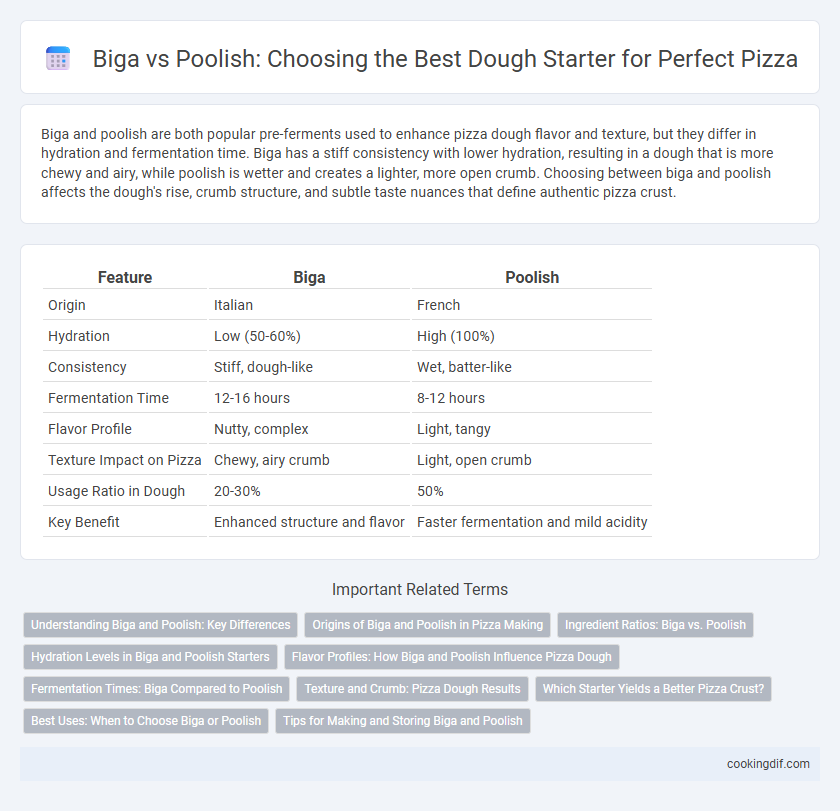Biga and poolish are both popular pre-ferments used to enhance pizza dough flavor and texture, but they differ in hydration and fermentation time. Biga has a stiff consistency with lower hydration, resulting in a dough that is more chewy and airy, while poolish is wetter and creates a lighter, more open crumb. Choosing between biga and poolish affects the dough's rise, crumb structure, and subtle taste nuances that define authentic pizza crust.
Table of Comparison
| Feature | Biga | Poolish |
|---|---|---|
| Origin | Italian | French |
| Hydration | Low (50-60%) | High (100%) |
| Consistency | Stiff, dough-like | Wet, batter-like |
| Fermentation Time | 12-16 hours | 8-12 hours |
| Flavor Profile | Nutty, complex | Light, tangy |
| Texture Impact on Pizza | Chewy, airy crumb | Light, open crumb |
| Usage Ratio in Dough | 20-30% | 50% |
| Key Benefit | Enhanced structure and flavor | Faster fermentation and mild acidity |
Understanding Biga and Poolish: Key Differences
Biga and poolish are two popular types of pre-ferments used in pizza dough preparation, each impacting texture and flavor differently. Biga is a stiff starter with low hydration, resulting in a dough that offers a chewy, slightly nutty crust with enhanced structure, while poolish is a wetter, more fluid starter with equal parts water and flour, contributing to a lighter, airier crumb and a subtle tangy taste. Understanding these differences helps pizza makers select the ideal starter to achieve the desired dough characteristics and flavor profile.
Origins of Biga and Poolish in Pizza Making
Biga originated in Italian baking as a firm, pre-fermentation dough starter enhancing the flavor and texture of traditional Neapolitan pizza crusts, using a small amount of yeast and extended fermentation time. Poolish, with roots in French baking, is a wet, sponge-like starter created with equal parts flour and water plus yeast, contributing to an open crumb structure and subtle sourdough notes in pizza dough. Both starters improve dough extensibility and fermentation but reflect distinct regional techniques that shape the final pizza's taste and crust characteristics.
Ingredient Ratios: Biga vs. Poolish
Biga typically uses a lower hydration ratio, around 50-60% water to flour, resulting in a stiff, firm dough starter that develops a tighter gluten structure and enhances dough strength. In contrast, Poolish has a 100% hydration ratio, meaning equal parts flour and water by weight, producing a wetter, more batter-like starter that promotes extensive fermentation and flavor complexity. These ingredient ratios significantly influence the dough's extensibility and texture, making Biga ideal for chewy crusts while Poolish yields a lighter, airier crumb.
Hydration Levels in Biga and Poolish Starters
Biga starters typically have lower hydration levels, ranging from 50% to 60%, resulting in a stiffer dough that enhances gluten development and provides a chewy texture ideal for pizzas requiring a crisp crust. Poolish starters feature higher hydration levels, generally 100%, creating a more batter-like consistency that promotes enzymatic activity and fermentation, yielding a lighter, airier dough with a subtle tang. Understanding these hydration differences in biga and poolish influences dough handling, fermentation speed, and final pizza crust characteristics.
Flavor Profiles: How Biga and Poolish Influence Pizza Dough
Biga imparts a nutty, complex flavor and a firmer texture to pizza dough due to its lower hydration and longer fermentation process. Poolish, being more hydrated, results in a lighter, more aromatic crust with pronounced yeast and slightly tangy notes. The choice between Biga and Poolish significantly affects the dough's extensibility and flavor depth, shaping the overall pizza eating experience.
Fermentation Times: Biga Compared to Poolish
Biga fermentation typically ranges from 12 to 16 hours at room temperature, resulting in a denser starter with more complex flavors and improved dough strength. Poolish ferments faster, usually between 8 to 12 hours, producing a wetter, more extensible dough with a mild tangy flavor. The choice between biga and poolish impacts dough texture and handling, influenced primarily by their distinct fermentation times and hydration levels.
Texture and Crumb: Pizza Dough Results
Biga produces a pizza dough with a denser texture and tighter crumb, lending a chewier bite ideal for traditional Neapolitan-style pizzas. Poolish develops a lighter, more open crumb structure, creating a softer, airier texture that enhances the dough's extensibility and oven spring. The choice between biga and poolish directly impacts dough elasticity and crust crispness, influencing the final pizza experience.
Which Starter Yields a Better Pizza Crust?
Biga and poolish are two popular pizza dough starters that impact crust texture and flavor differently. Biga, a stiff starter with lower hydration, yields a chewier, more open crumb and enhances a nutty, complex flavor ideal for traditional Italian-style pizzas. Poolish, being a wetter, highly hydrated starter, produces a lighter, airier crust with a slightly tangy taste, making it suitable for achieving a soft and crisp pizza crust.
Best Uses: When to Choose Biga or Poolish
Biga is ideal for rustic, chewy pizza crusts that benefit from a longer fermentation and a slightly nutty flavor, commonly used in Italian-style pizzas like Neapolitan and Roman. Poolish offers a lighter, airier texture and is best suited for pizza doughs requiring a softer crumb and faster fermentation, often preferred in French-style or New York-style pizzas. Choosing between Biga and Poolish depends on desired crust texture and fermentation time, with Biga favoring extended proofing and Poolish enabling quicker dough readiness.
Tips for Making and Storing Biga and Poolish
Biga should be mixed with less water to create a stiff starter, stored in a cool environment around 60-65degF to slow fermentation and enhance flavor complexity. Poolish requires equal parts water and flour for a batter-like consistency, and benefits from refrigeration after initial fermentation to prevent over-proofing. Both starters should be covered loosely to allow gas escape, and used within 12-24 hours for optimal yeast activity and dough strength.
Biga vs Poolish for dough starter Infographic

 cookingdif.com
cookingdif.com